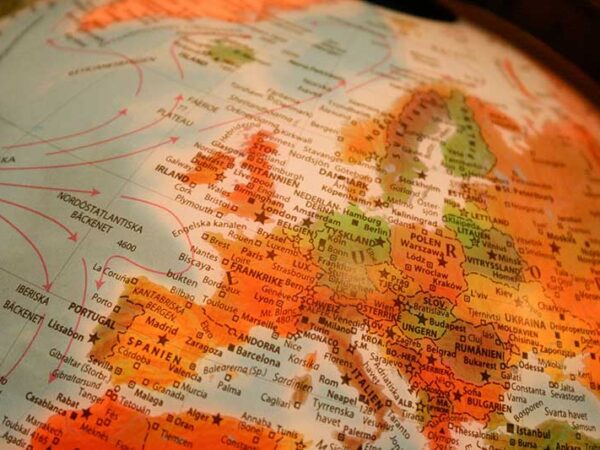The European Union is an economic and political grouping of twenty-seven countries that cooperate with each other to improve commerce and security within the member states. The concept of neighbouring countries working with each other to improve trade originated in 1951 with the signing of the Treaty of Paris. This saw six neighbouring European countries establish the European Community of Coal and Steel (ECSC) with the six countries being France, Belgium, Luxembourg, Italy, the Netherlands and West Germany.
The ECSC proved a tremendous success as each of the member states benefited from relaxed cross-border trading, travel and tourism and other European countries soon applied for admission to the group. Over the following decades, the ECSC added new member states and went through several name changes before becoming what is now known as the European Union in 1993.
The EU has headquarters in Brussels and Luxembourg, and the majority of member states use the euro as the unit of the currency, although there are exceptions to this standard in the following countries:
- Poland (zloty)
- Hungary (forint)
- Denmark (krone)
- Czech Republic (koruna)
- Croatia (kuna)
- Romania (leu)
- Sweden (krona)
- Bulgaria (lev)
Although these countries have retained their own currency, the euro is (or should be) accepted in all of them. The euro is generally accepted in larger towns and cities and by bigger shops and vendors. However, there is no legal obligation to accept euros in any of these countries despite EU membership.
Little and Large
Seven countries have applied for EU membership, or are currently close to becoming members of the European Union. Of the current 27 member states, France has the largest land area while Germany has the most inhabitants. Malta ranks as the smallest EU country both in population and size.
In total there are almost 448 million people living in the European Union which covers just over 4 million sq km (slightly over 1.5 million square miles), stretching from Spain to Cyprus along the southern edge to Sweden and Finland in the north.
Most Populated
According to 2022 figures, Germany has the highest population, with a total of 83.3 million inhabitants. In the early 1970s, the annual national death rate in Germany exceeded the birth rate, and the overall number of citizens began to drop accordingly. In the last fifteen years, however, this trend has been reversed, and the opposite is now true.
Germany is also one of the world’s most popular destinations for immigrants who have arrived in the country in ever-increasing numbers in the last decade. Recent immigration and the rising birth rates have meant the German population has been steadily increasing in recent years.
France sits in second place with a population of 67.8 million, followed by Italy at just under 60 million.
Least Populated
Malta is not just a small country, it also has very few inhabitants. The total population of just over 500,000 is comprised mainly of Maltese natives, but there is a large minority of Britons, mainly retirees, who call the island home. However, the smallest EU country with the lowest population, Malta, has one of the highest population densities in the world, with approximately 1,300 people per square kilometre (3,320 per square mile).
Luxembourg has the second-lowest population in the EU at 650,000, and Cyprus is the only other EU country with a population of less than a million with a 2022 count of 905,000.
Biggest
France, covering more than 640,000 sq km (248,000 sq miles), is the biggest EU country by some distance and ranks in the top twenty most populous countries in the world. With an unusually high birth rate, France was solely responsible for all EU population growth in 2006, and the country continues to exceed the average live births statistics regularly. Due to France’s colonisation of countries in the past, the country is now multicultural as millions of immigrants have relocated in the past century, mainly from African countries.
Spain ranks as the second biggest EU country with a land area of 505,000 sq km (195,000 sq miles), with Sweden, rather surprisingly, in third place, covering 440,000 sq km (170,000)
Smallest
Malta has the distinction of being, by some distance, the smallest EU member country. The island nation is tiny, with a land area of just 315 sq km or 122 sq miles. Malta is actually an archipelago, but only the three biggest islands of Malta, Comino and Gozo, are inhabited. It is the only European Union member state where abortions are illegal except in cases of incest or rape. Luxembourg and Cyprus, in that order, are the next smallest EU countries.
Demographic Future of EU
Future rises or decreases in population levels across the 27 current European Union member states are problematic, if not impossible, to predict with any degree of certainty. Four main factors will affect future population growth (or decrease), which must be taken into account:
- Average life expectancy
- Ageing population
- Fluctuations in immigration
- Fertility rates
Life Expectancy
According to figures in 2020, the average life expectancy of EU citizens was 80.4 years. Women averaged almost six years longer than men at 83.2 years, with males at 77.5 years. This was a decrease of almost one year on the previous year’s statistics, but the figures will have been skewed somewhat by fatalities due to the coronavirus pandemic, which struck in 2020.
The highest figures were found on Corsica and the Balearic Islands, with both regions approaching an average life expectancy of 84 years. Bulgaria recorded the lowest average lifespans of 72 and 73 years across the country.
Even allowing for the effects of the coronavirus pandemic, average life expectancy has been decreasing slightly across the EU over the last ten years. This trend is expected to continue in the immediate future.
Ageing Population
In 2023 there will be an estimated 100 million EU citizens aged sixty-five or more. This equates to around one-fifth of the total EU population and poses a real problem for Europe. If the average life expectancy remains the same, then there will be almost 150 million older EU citizens by 2050, constituting almost a third of the entire EU population.
With birth rates down, a life expectancy of eighty years or more and health care constantly improving, the European Union will face serious problems with an ageing population and huge pressures on pension funding and healthcare.
Immigration
In the past decade, the number of legal and illegal immigrants arriving in virtually all of the EU member countries has been increasing dramatically year upon year. In 2021 more than 2.3 million immigrants arrived in the EU from countries outside of the European Union. This was balanced, to some extent, by the estimated one million EU citizens who emigrated to a non-EU country but still represents a significant increase in the overall EU population.
2021 Statistics show that Germany received the highest number of immigrants, with almost 875,000, followed by Spain, with 530,000. Since 2020 virtually all EU member states have reported increased numbers of immigrants entering their countries either as asylum seekers or economic migrants. Today in 2023, the numbers continue to increase steadily, and whether the immigrants remain or leave, the substantial influx of people is bound to affect the total EU population and demographics.
Fertility
From a historic low of an average of 1.47 children per female, the fertility rate across the EU has now risen to over 1.6. This means that more children are being born in the EU than was previously the case, and the upward trend has been observed in all but three EU member states: Portugal, Malta and Luxembourg.
However, 1.6 children per female is still a fairly low average rate and is insufficient to replace current workers as they reach retirement age. This means that the EU will face problems (if not a crisis) in funding retirement pensions as income taxes steadily decline.
Expanded European Union
With seven countries currently candidates to join the twenty-seven existing European Union states, an expanded EU is a certainty within the next few years. This will mean that EU citizens will have an additional seven countries they can visit, work, study or live in without any special form of visa or documentation.
Non-EU nationals, however, will also benefit as the ETIAS (European Travel Information and Authorisation System) will also be valid in any new EU member state. A Schengen Visa will not be required unless, or until, the new member states sign up to the Schengen Agreement, which, though a possibility, is unlikely to happen for some years.




